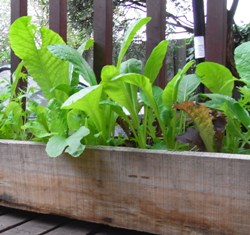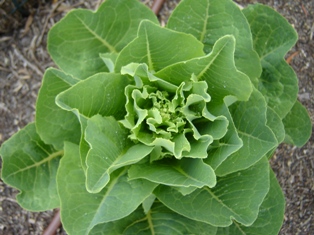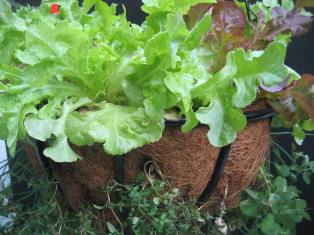Lettuce (Lactuca sativa) – a reliable summer favourite, salad filler and sandwich staple! But it can be grown year round, with very little tender loving care after making sure that there is adequate feed. With a large variety of types and therefore flavours, lettuce isn’t just reduced to your Cos or iceberg! Available as seedlings, but also germinates readily from seed. Sprinkle in some seed at any time of year and this quick growing vegetable will be ready in weeks.
Planting Schedule
Warm Areas: All Year Round!
Temperate Areas: All Year Round!
Cool to Cold Areas: All Year Round!
Position
Lettuce is traditionally a cool season veggie (a bit like coriander), which means they prefer to be planted in cooler weather. However modern plant breeding means there are now lettuces available acrossAustraliathat are suitable for planting all year long. There are so many varieties of lettuce available for gardens now that if we included them here, this would be a very long article. Instead we suggest that you go to your local garden centre to find out what’s available locally.
Now, remembering that lettuce are cool season plants, we recommend planting them in partially shaded spots in your patch or plot. Especially if you are in an area prone to stinking hot summers. Consider using some other patch residents, like beans and sweet corn, as “living shade” or erect a shade tent in hotter months.
Soil Preparation and Feeding 
Lettuce needs a well-drained soil with loads of organic matter (like crumbly compost), a bit of a seaweed feed and some lovely mulch. New seedlings will benefit when soil is prepared soil about two weeks before planting. Do this by lightly working compost and a little bit of pelletised manure based fertiliser through the soil, followed by mulch, to a depth of about 5-7cm. Walk away, and count the days to planting time. Oh, and don’t be afraid to test your pH… 6.5 is just fine!
Lettuces are a heavier feeder as they grow quite rapidly and produce a lot of leaves per plant. They need to be grown quickly for best flavour and appearance. The best way to ensure this is to make sure you prepare your beds correctly with composts and manures. Using large amounts of commercial liquid fertilisers on lettuce seedlings will encourage growth, but it also encourages hordes of snails who feast on the soft lettuce growth! It’s not necessary and it’s financially and ecologically more sustainable to use good bed preparation.
If you do feel the need to feed, do it fortnightly, at half strength, using a manure/compost tea. You can also deliver a half strength seaweed solution at planting time, as this is great for encouraging robust root growth.
Watering
Water is vital. Lettuces have shallow roots and thus need frequent watering, especially in hot and/or windy weather. Keep the area well mulched and test soil moisture regularly.
If soil is left to dry out, lettuce may run to seed creating a wasted plant, taste bitter or unfortunately die. All of which can be avoided.
Varieties
Lettuces are big fans of position and timing. This determines how long it takes them all to mature. A partial guide has been prepared for you, but with most ‘guides’ things vary, depending on where you are; 
- Crisphead varieties (which includes the ubiquitous Icebergs) take about ten to twelve weeks to mature, and should be harvested roots and all.
- Butterheads are similar to crispies, only smaller. They take about nine – ten weeks to be ready for eating. Included in these are mignonettes, oak leaf and butter varieties, and are best harvested as required.
- Cos varieties are my favourites, take about ten – eleven weeks to grow up, and outer leaves can be harvested while the lettuce is still growing. Cos lettuce are great in cooler climes, and can easily become a winter favourite.
- Loose Leaf lettuces are also harvested while growing, and can be eaten from about six weeks onwards. These guys are heartless so therefore can be picked as needed.
Pests
 Snails are by far the biggest pest associated with lettuce, as are slugs and earwigs to a lesser extent. There are a range of options to deter these salad munching thieves before they get to your lunch. One environmentally beneficial suggestion is coffee grounds spread around your patch, either your own or contact your local café. They usually appreciate not having to throw away something that is just waste to them. Set up a beer trap, see the snails factsheet for this and other great tips on how discourage snails and slugs. These suggestions will also benefit other plants in your patch that these critters may be attracted to.
Snails are by far the biggest pest associated with lettuce, as are slugs and earwigs to a lesser extent. There are a range of options to deter these salad munching thieves before they get to your lunch. One environmentally beneficial suggestion is coffee grounds spread around your patch, either your own or contact your local café. They usually appreciate not having to throw away something that is just waste to them. Set up a beer trap, see the snails factsheet for this and other great tips on how discourage snails and slugs. These suggestions will also benefit other plants in your patch that these critters may be attracted to.
Remember, “Iceberg” is not the only lettuce around, try a variety of lettuces. Have a look around in your garden shop or nursery, most nurseries will sell a lettuce mix as well as punnet’s of a particular ‘type’. Have a look at what seeds they sell also, as this will more give you even more variety of colour, flavour, growing habits.
Related Articles:
Garden Journaling – Slow down to tune in.
As we move through the year and our gardens evolve, there's something magical about documenting the journey. Garden journaling is an art that enables…
The Importance of building soil health for a biodeverse, productive garden
Creating a thriving garden that not only sustains itself but also contributes to the broader ecosystem requires more than just sunlight and water.…




